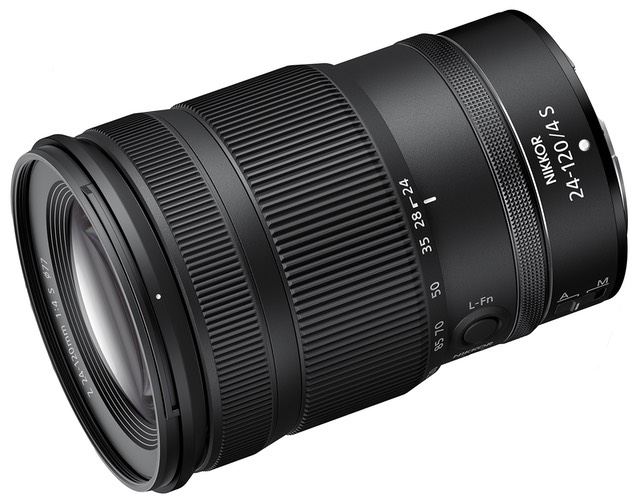
What is It?
The 24-120mm f/4 S produced a little bit of a surprise when it was announced in late October, 2021. That's because the lens that had been previously leaked in the Road Map was assumed to be a 24-105mm, and also rumored to be a variable aperture one (f/2.8-4). What happened between leaks and release is unknown. Was this an intentional ploy on Nikon's part to confuse competitors, or simply that one design version of a longer mid-range zoom won out as we got close to production?
In the end, we got a lens that matches up well with what we had in the Nikon DSLR days: a 24-120mm f/4. But one that's lighter (by 2.8 ounces, or 80g), though a bit longer (by a half inch, or 14mm, in the collapsed position). Technically, though, you'd have to add the 30mm FTZ adapter to use the F-mount version on a Nikon Z body, so using the Z-mount version ends up being about a half inch shorter in your Z System bag, and significantly lighter (7.5 ounces, or 213g).
Another small surprise was that the 24-120mm began shipping with 40 days after announcement. Originally it had been expected to not arrive until the first quarter of 2022. Even Nikon themselves suggested that would be the case (and apparently was in some markets).
Curiously the Z-mount 24-120mm f/4 is optically both less and more complex than the F-mount version. Overall, it loses one element (16 elements in 13 groups), but adds some complexity in the elements that remain (3 aspherical and 3 low dispersion elements plus 1 combined aspherical/low dispersion element, compared to the F-mount's 3 aspherical and 2 low dispersion elements). The Z-mount lens also gets Nano and Arneo coating to reduce flare and ghosting, plus fluorine coating on the front element to better shed dust and water.
Another change is in the focus ability of the lens. First up, the Z version focuses closer (0.35m versus 0.45m), which produces a near macro capability of 1:2.4 maximum magnification. For you Americans, that's a bit less than 15" for close focusing, with a working distance of just over 6" (0.16m). Focus is achieved with two stepping motors that move two different groups of elements within the lens. Nikon is careful to say that focus breathing is suppressed, not eliminated, with this lens.
Up front, you have a 77mm filter ring and a supplied HB-102 bayonet-style lens hood.
Zoom markings are supplied at 24, 28, 35, 50, 70, 85, and 120mm on a very wide and easily found zoom ring, but there is no LED display (as on the 24-70mm f/2.8 S) to show aperture, focus distance, or depth of field. During zoom the lens front telescopes forward by 2" (52mm) as you zoom from 24mm to 120mm. With hood attached, that means that the front part of the hood is nearly 8.5" (almost 220mm) forward of the lens mount.
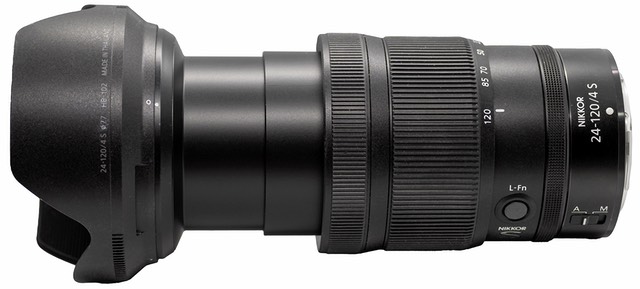
The lens has one switch (A/M), one button (L-Fn), and a third programmable control ring. So in terms of its "S-ness", it's mid-pack in terms of additional features. Likewise, there's no lens VR in this design, so you'll be relying on sensor-VR to stabilize your images.
Build quality is typical S-line. Polycarbonate external housing over metal frame interior, with weather sealing throughout, including a rubber ring at the lens mount.
The 24-120mm f/4 S is made in Thailand and has a list price of US$1100.
Source of the reviewed lens: purchased via NPS Priority Purchase.
How's it Handle?
The zoom ring takes you from wide angle to telephoto maximums in just under a quarter of a turn (about 80°). While the ring moves smoothly-but-with-resistance while doing so, the minimal turn does making dialing in small focal length changes exactly as you want them a little more challenging. The resistance means that the lens isn't prone to focal length creep due to gravity when tilted.
The minor issues with the handling are two-fold. First, the 24-120mm f/4 S is a bigger lens than the 24-70mm f/4 S. For casual walk-around use, that does tend to make a bit of difference. I found myself having to watch from bumping the front of the lens into things while walking about, particularly if I had left it in the telephoto extended position. Walking around in crowded travel locations I found my lens bumped more than, say, the 24-70mm would have (particularly when that lens is in the collapsed position).
But the thing that bothers me more is this: where the focus ring is. In the six mid-range zooms we currently have two with focus rings at the front, four with rings at the back. This is a design issue that Nikon has been pushing with the Z-mount lenses: if the lens has three rings, the focus ring moves to the front, but if it has two the focus ring moves to the back. Interestingly, Nikon doesn't allow you to assign focus to that third ring, would would solve the problem. (And the two telephoto zooms—70-200mm and 100-400mm—add yet another wrinkle by putting the focus ring in the middle!)
Now granted, I'm not manually focusing as often as I used to with the Nikon DSLRs, as I'm finding I don't have to override the autofocus system nearly as much with the Z System cameras, but still, cognitive dissonances are cognitive dissonances, and should be avoided in design foundations.
A subtler example of that is the location where Nikon puts the Nikkor S logo versus the L-Fn button on lenses. These (now) go on the same flat area of a lens, but with the 24-120mm the logo is at the horizontal position and the L-Fn button is just above that, while on the 100-400mm lens, for example, the L-Fn2 button is at the horizontal position and the Nikon S logo is above it. Message to Nikon: I don't want to find the logo with my left thumb first! The button should always be the priority.
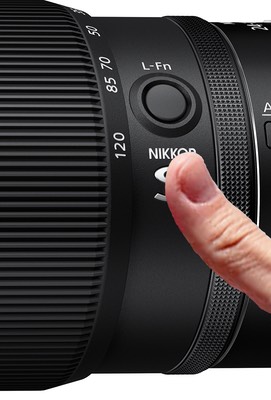
How's it Perform?
Focus: There is a modest amount of focus breathing when you do a full close up to infinity focus pull, particularly at the telephoto end. It's minimal enough that you probably wouldn't notice breathing in normal focus pulls. So, suppressed, not eliminated.
Actual focus speed can be quite fast (and very quiet) in good light with the correct AF-Area mode set. In most cases, I didn't notice focus speed, at all, because the lens just snapped to focus. However, in low light and contrast sometimes you can trigger "hunts," and then the close focus ability of the lens gets in the way, as the hunt will perform a full in and out.

Sharpness: A lot to write about here. Let's start with the lens wide open through the zoom range. At f/4, central performance is excellent from 24 to 70mm, only very good at 120mm. The DX frame is right at the very good/excellent boundary out through 70mm, then falls to my good/very good boundary at 120mm. The FX corners are good at 24mm and reach very good by 50mm, but fall to fair by 120mm. While to some this may sound "not so good," it's actually quite good performance compared to all the other 5x mid-range zooms, and at f/4 it beats the 24-70mm f/4 S by a small margin, at least out through 50mm.

Left frame edge to right frame edge at the middle of the frame vertically, taken at 38mm and f/4.
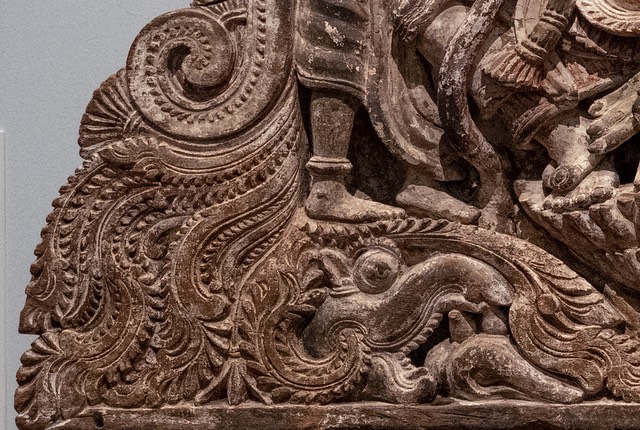
Left frame edge 100%
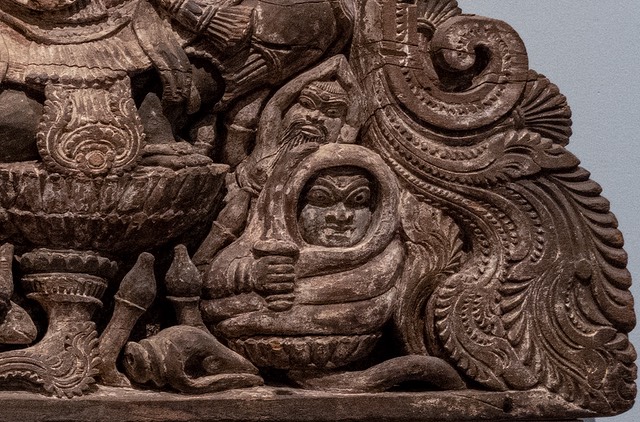
Right frame edge 100%. If there's any difference in acuity here, it would be because I'm not perfectly parallel to the art, but there's really little difference I can see.
At minimum focus distance (1:2.4, which is getting near macro range) the lens is very good in the center at f/4, excellent by f/8. The DX corner is fair at f/4, good by f/8. The far FX corners never make it past fair at minimum focus distance, though. I'd also judge the lens to have some clear field curvature at close distance.
At long focus distances, I'd say the lens improves significantly from what I just described. Infinity shows very little sharpness change towards the FX corner, though a bit of field curvature at the long end (and far less than at close focus). Indeed, 120mm extreme corners at near infinity look relatively good. I do see a small amount of focus shift towards infinity, though, at smaller apertures.
I've seen some other published examples that show some side-to-side issues, but my sample appears to be quite well controlled and thus well aligned.
Coma is extremely well controlled, particularly for a 5x zoom. While not perfect, points stay near to being points and show no color fringing. Astigmatism is less well controlled, especially past the DX frame line and especially at the telephoto end. Still, a reasonable showing.
Linear Distortion: Auto Distortion corrections cannot be disabled in camera or in Adobe's raw software. The profile does a pretty good job of removing all distortion.
Chromatic Aberration: Even though f/4 isn't a particularly fast aperture, I see clear longitudinal CA at f/4, which mostly goes away by f/5.6. Lateral CA is minimal and well controlled, especially when using the lens corrections.
Vignetting: At 24mm the image circle area stays bright out through the top/bottom frame edge, leaving only the corners to darken, and they don't do so by a lot (~2 stops). Stopping down a stop makes the vignetting mostly ignorable except for the extreme corners, which always show some cutoff. The in-camera corrections, ironically, don't do a lot at 24mm at Normal value.
35mm is probably the best focal length for vignetting, and I'd tend to judge it a mild (~1 stop) wide open and most ignorable as you stop down. 50mm and 70mm have a bit more corner vignetting, but they also improve more with stopping down.
At 120mm vignetting is also more pronounced and nearing 2 stops again, and the edges of the most dramatic vignetting are in further from the corners. You really have to stop down to f/8 to get to an ignorable level with corrections, and without corrections you'll always have at least a stop of vignetting in the corners.
Flare: 24mm is remarkably good with light sources in and near frame edge. Even veiling flare is well handled. I was only able to produce clear colored ghosting artifacts at the telephoto end, and only rarely.
Bokeh: Cats eyes show up past the DX boundary, even as you stop down. There's a large amount of onion skinning, plus a bright edge to out of focus highlights. Wide open that bright ring shows a tiny bit of coloration (longitudinal CA caused). I will say that the out of focus areas seem to be just a little less "busy" and distracting than I've seen on other lenses at the telephoto lengths, but some will find it still a bit on the busy side.

Compared to the 24-120mm f/4G: Nikon's own MTF charts tell you most of what you need to know: the Z-mount lens is simply better. It retains central performance over a much larger area, and has much better edge/corner performance. This is more true at the wide angle end than the telephoto end, but still basically true at all focal lengths. It focuses closer. It has no issues with aberrations or flare. The bokeh looks better. No contest, really.
Final Words
Nikon is now giving us six choices to cover the mid-range focal lengths with zooms (24-50mm, 24-70mm f/2.8 and f/4, 24-120mm f/4, 28-75mm f/2.8, and 24-200mm). That's a lot, and likely to now start causing confusion. While I haven't tested the 28-75mm f/2.8 version yet, I've tested all the others and will say this: the 24-120mm f/4 S is the best choice if you're trying to balance versatility versus performance.
The best of the bunch overall is the 24-70mm f/2.8 S, no doubt. But the 24-120mm f/4 S hangs in close enough so that if you don't need that extra stop of light, it's well worth considering for its extra focal range. The 24-200mm f/4-6.3 also has reasonably good performance, but that variable aperture means you aren't exactly comparing apples with apples at 50mm-120mm; you're always at least a stop down, and stopping down improves the 24-120mm f/4 S further, as you'd expect.
The lens the 24-120mm f/4 gives doubt to is the 24-70mm f/4 S, which is a fine lens on its own, but has a relative restrictive focal range that's a little weaker at the wide angle end than the lens being reviewed. The 24-70mm f/4 S excels for travel due to its more compact size, but if that means you have to bring along another lens to cover the telephoto range, the 24-120mm f/4 S suddenly becomes a clearer choice. That said, the 24-70mm f/4 S often comes with a steep discount when bought in a camera+lens bundle, so cost can come into play, too.
Frankly, I wasn't expecting to like the 24-120mm f/4 S. That was clouded by my opinion of the two previous Nikkor 24-120mm lenses in the F-mount, which both had very clear liabilities. There's little doubt in my mind that the new Z-mount version runs rings around those older F-mount ones, and I'm now wondering whether or not to move my Z7 II travel kit to the 14-24mm f/2.8 S and 24-120mm f/4 S to optimize the optics. (Another two-lens travel kit that makes sense for those willing to compromise would be the 14-30mm f/4 and 24-200mm f/4-6.3).
No, the 24-120mm f/4 S isn't the best performer at 120mm—the telephoto end is its weaker end—but it's also f/4 throughout its range, which is useful in keeping ISO down at times on the 45mp cameras (most of the examples shown in this review were at ISO 1600 or 3200 on a Z9).
On DX cameras the liability of the 24-120mm f/4 S is obvious: no VR. That makes the 18-140mm f/3.5-6.3 VR DX lens the better choice for this focal range on the Z50 and Zfc.
Recommended (2022)
Support this site by purchasing from the following advertiser:
